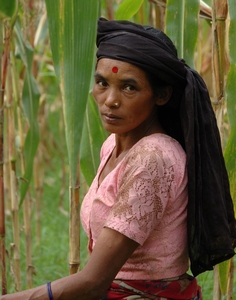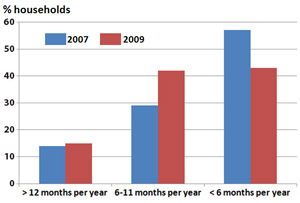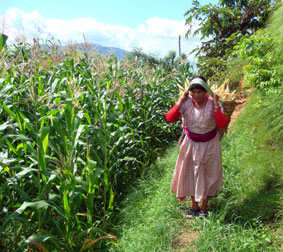 More than two decades of joint efforts between researchers from Nepal and CIMMYT have helped boost the country’s maize yields 36% and those of wheat by 85%, according to a report compiled to mark the 25th anniversary of the partnership. As a result, farmers even in the country’s remote, mid hill mountain areas have more food and brighter futures.
More than two decades of joint efforts between researchers from Nepal and CIMMYT have helped boost the country’s maize yields 36% and those of wheat by 85%, according to a report compiled to mark the 25th anniversary of the partnership. As a result, farmers even in the country’s remote, mid hill mountain areas have more food and brighter futures.
Anywhere else, peaks above 3,000 meters would be called “mountains,” but a nation whose collective psyche has been shaped by the towering Himalayas refers to its rugged heartland as merely the “mid-hills.” Comprising deep river valleys and high ridge tops, peppered toward the north with sloping farm terraces, the mid-hills account for more than four-tenths of Nepal’s total land area. They are home to isolated villages whose inhabitants’ lives hold strongly to tradition.
One such villager is Bishnu Maya Nepali, 45 from, Belhara village of Dhankuta district. She is a farmer and a single mother of three. Maya is a “dalit,” one of the poorest castes in the Nepal’s traditional caste hierarchical system.
Up until a few years ago, Maya maintained a hardscrabble existence by planting maize, the region’s main food crop. Like many area farmers, it wasn’t enough. Her farm–which is roughly the size of a soccer field–didn’t produce enough food to feed her family.
Maya’s life began to change in 2006 when she was approached by members of the HMRP. Maya was asked to test maize varieties bred for the mid-hills by the Nepal Agriculture Research Council (NARC) with CIMMYT as one of the partners. She agreed and eventually decided to plant a type of maize, called Manakamana 3, which produced two large ears per plant and which had a shorter, sturdier stalk. To her delight, the new plant thrived. Maya’s maize harvests grew 20-50%. She also discovered the plant stayed green as it matured, providing better forage for her livestock. The project advised Maya to plant vegetables in addition to maize. These intercrops also did well, bringing Maya additional food and income. Maya grew enough food to feed her three children all year long. “Now I have enough food and can sell some surplus to pay for my children’s education,” she said. Maya’s additional income allowed her to put her children into school and even make modest improvements to her homestead.
Support for an agrarian way of life
Nepal is a nation of incredible diversity that depends heavily on agriculture. Of the Nepalese population, 84% live in rural areas and, during the growing season, four of every five adults of the rural population are engaged in agriculture.
In September 2010, Nepal and CIMMYT celebrated 25 years of partnership in developing and spreading improved maize and wheat varieties and cropping practices in benefit of Nepalese farmers and researchers. Given the country’s reliance on agriculture and its financial constraints, the partnership has been invaluable. “Maya’s case is just one example of this,” says Guillermo Ortíz-Ferrara, researcher and liaison officer for CIMMYT’s office in Nepal. The joint efforts have helped raise maize yields 36% and those of wheat by 85%, while 170 Nepali researchers have benefited from CIMMYT training and joint research or fellowships. “The partnership that CIMMYT has maintained over the past 25 years with our research and development institutions in Nepal has been very useful and of significant value to increase maize and wheat production,” says Dr. K.K. Lal, one of the very first CIMMYT maize trainees and former Joint Secretary in the Ministry of Agriculture and Cooperatives of Nepal. “This partnership should continue and be strengthened.”

An internal report on HMRP outcomes for 2008-10 by the Swiss Agency for Development and Cooperation showed significant improvements in food security for the more than 21,000 households taking part in the project, with particular focus on women and disadvantaged groups like dalits: the proportion of the population in the groups having food sufficiency throughout most or all of the year (first two sets of bars) grew, while the proportion of the food-insecure—those with enough food for less than six months of the year (last set of bars)—fell.
The Hill Maize Research Program
Begun in 1999 with the cooperation of the National Maize Research Program (NMRP) of the Nepal Agriculture Research Council (NARC), the Hill Maize Research Program (HMRP) promotes the development and adoption of new technologies (improved varieties and crop management) in the hills of Nepal. Funded by the Swiss Agency for Development and Cooperation (SDC), the HMRP works with government, non-government organizations, farmers groups and cooperatives and the private sector to develop and disseminate maize technologies that benefit poor farmers in the Nepali hills. With HMRP-CIMMYT support, NMRP has developed 12 improved maize varieties for commercial production and identified more than 15 promising inbred lines, including 4 QPM lines. These 12 improved maize varieties were released by National Seed Board (NSB) of Government of Nepal. By 2009, 174 farmers groups had produced 664 tons of improved maize seed, increasing maize productivity by at least 30%. A new 2010-14 phase of the HMRP continues the focus on improving the food security and incomes of Nepal hill farm families, especially the poor and disadvantaged. Partners include the Ministry of Agriculture and Cooperatives (MoAC), the Nepal Agricultural Research Council (NARC), the Department of Agriculture (DoA), more than 26 NGOs/CBOs, and thousands of poor farmers. The new phase is jointly funded by SDC and the United States Agency for International Development (USAID).
Winning with wheat
Along with maize, the importance of wheat as a food and cash crop has grown in Nepal. As a result of high-yielding Mexican varieties introduced through CIMMYT during the mid-1960s and intensive research and development efforts by the national partners, Nepal’s wheat area has increased 7-fold, its production 14-fold, and its productivity 2-fold. Overall, yield gains from the release of new varieties in Nepal have averaged 3.5% per year since 1985, which equals or exceeds the yield gains seen in neighboring countries where the Green Revolution began.
 During 1997-2008, Nepal’s National Wheat Research Program (NWRP) worked in partnership with CIMMYT, involving farmers in varietal selection and distributing regional nurseries—sets of experimental wheat lines sent out for widespread testing and possible use in breeding programs. Two wheat varieties distributed this way, and bred by the NWRP, have been released in Bangladesh, and a significant number of other Nepali breeding lines have been used in research programs of Nepal and in eastern India.
During 1997-2008, Nepal’s National Wheat Research Program (NWRP) worked in partnership with CIMMYT, involving farmers in varietal selection and distributing regional nurseries—sets of experimental wheat lines sent out for widespread testing and possible use in breeding programs. Two wheat varieties distributed this way, and bred by the NWRP, have been released in Bangladesh, and a significant number of other Nepali breeding lines have been used in research programs of Nepal and in eastern India.
Farming systems for a tough future
The Nepal-CIMMYT partnership has addressed important farming concerns with research and recommendations on varieties for timely and late sown conditions, appropriate weed management, balanced application of fertilizers, irrigation schedules, and resource-conserving practices such as surface seeding, zero and minimum tillage, and bed planting. The best results have included reduced costs for cropping, greater efficiency of input use, and increases of a ton or more per hectare in grain yields.
“South Asia will suffer particularly harsh effects from climate change, according to experts,” says Mr. Kamal Aryal, Agriculture/Climate Change Researcher, ICIMOD, Kathmandu, Nepal. “More input-efficient cropping systems will help farmers face the challenges expected.”
For more information: Guillermo Ortiz-Ferrara, cereal breeder (g.ortiz-ferrara@cgiar.org)
 Nutrition, health and food security
Nutrition, health and food security